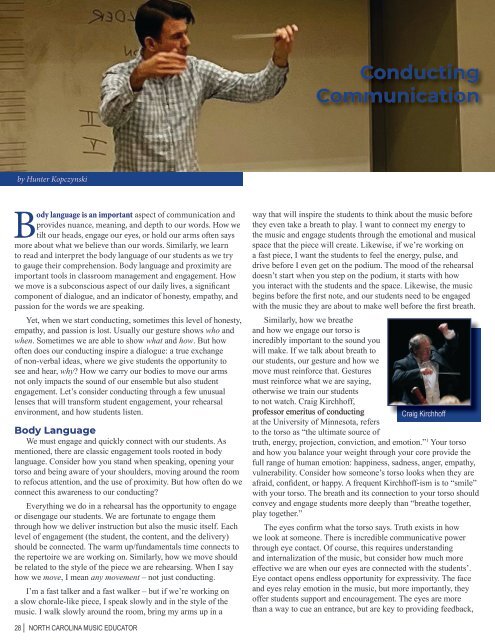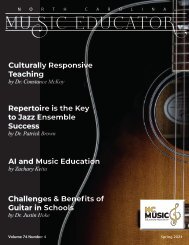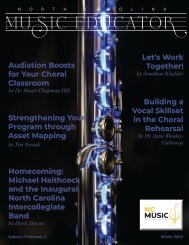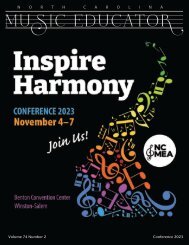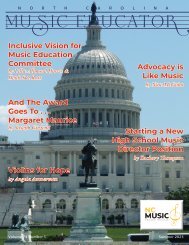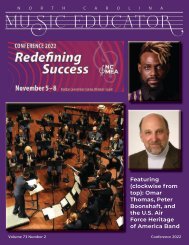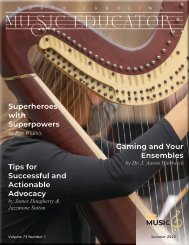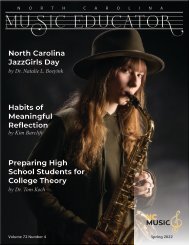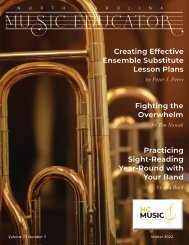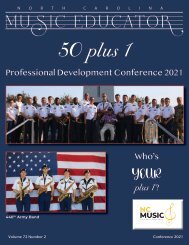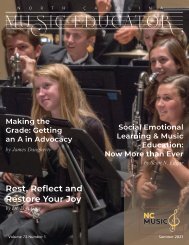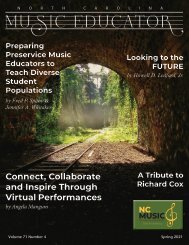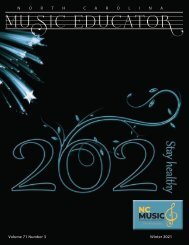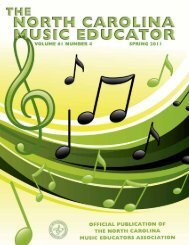North Carolina Music Educator Winter 2023
Professional journal for North Carolina Music Educators Association, winter 2023.
Professional journal for North Carolina Music Educators Association, winter 2023.
You also want an ePaper? Increase the reach of your titles
YUMPU automatically turns print PDFs into web optimized ePapers that Google loves.
y Hunter Kopczynski<br />
Body language is an important aspect of communication and<br />
provides nuance, meaning, and depth to our words. How we<br />
tilt our heads, engage our eyes, or hold our arms often says<br />
more about what we believe than our words. Similarly, we learn<br />
to read and interpret the body language of our students as we try<br />
to gauge their comprehension. Body language and proximity are<br />
important tools in classroom management and engagement. How<br />
we move is a subconscious aspect of our daily lives, a significant<br />
component of dialogue, and an indicator of honesty, empathy, and<br />
passion for the words we are speaking.<br />
Yet, when we start conducting, sometimes this level of honesty,<br />
empathy, and passion is lost. Usually our gesture shows who and<br />
when. Sometimes we are able to show what and how. But how<br />
often does our conducting inspire a dialogue: a true exchange<br />
of non-verbal ideas, where we give students the opportunity to<br />
see and hear, why? How we carry our bodies to move our arms<br />
not only impacts the sound of our ensemble but also student<br />
engagement. Let’s consider conducting through a few unusual<br />
lenses that will transform student engagement, your rehearsal<br />
environment, and how students listen.<br />
Body Language<br />
We must engage and quickly connect with our students. As<br />
mentioned, there are classic engagement tools rooted in body<br />
language. Consider how you stand when speaking, opening your<br />
torso and being aware of your shoulders, moving around the room<br />
to refocus attention, and the use of proximity. But how often do we<br />
connect this awareness to our conducting?<br />
Everything we do in a rehearsal has the opportunity to engage<br />
or disengage our students. We are fortunate to engage them<br />
through how we deliver instruction but also the music itself. Each<br />
level of engagement (the student, the content, and the delivery)<br />
should be connected. The warm up/fundamentals time connects to<br />
the repertoire we are working on. Similarly, how we move should<br />
be related to the style of the piece we are rehearsing. When I say<br />
how we move, I mean any movement – not just conducting.<br />
I’m a fast talker and a fast walker – but if we’re working on<br />
a slow chorale-like piece, I speak slowly and in the style of the<br />
music. I walk slowly around the room, bring my arms up in a<br />
Conducting<br />
Communication<br />
way that will inspire the students to think about the music before<br />
they even take a breath to play. I want to connect my energy to<br />
the music and engage students through the emotional and musical<br />
space that the piece will create. Likewise, if we’re working on<br />
a fast piece, I want the students to feel the energy, pulse, and<br />
drive before I even get on the podium. The mood of the rehearsal<br />
doesn’t start when you step on the podium, it starts with how<br />
you interact with the students and the space. Likewise, the music<br />
begins before the first note, and our students need to be engaged<br />
with the music they are about to make well before the first breath.<br />
Similarly, how we breathe<br />
and how we engage our torso is<br />
incredibly important to the sound you<br />
will make. If we talk about breath to<br />
our students, our gesture and how we<br />
move must reinforce that. Gestures<br />
must reinforce what we are saying,<br />
otherwise we train our students<br />
to not watch. Craig Kirchhoff,<br />
professor emeritus of conducting<br />
Craig Kirchhoff<br />
at the University of Minnesota, refers<br />
to the torso as “the ultimate source of<br />
truth, energy, projection, conviction, and emotion.” 1 Your torso<br />
and how you balance your weight through your core provide the<br />
full range of human emotion: happiness, sadness, anger, empathy,<br />
vulnerability. Consider how someone’s torso looks when they are<br />
afraid, confident, or happy. A frequent Kirchhoff-ism is to “smile”<br />
with your torso. The breath and its connection to your torso should<br />
convey and engage students more deeply than “breathe together,<br />
play together.”<br />
The eyes confirm what the torso says. Truth exists in how<br />
we look at someone. There is incredible communicative power<br />
through eye contact. Of course, this requires understanding<br />
and internalization of the music, but consider how much more<br />
effective we are when our eyes are connected with the students’.<br />
Eye contact opens endless opportunity for expressivity. The face<br />
and eyes relay emotion in the music, but more importantly, they<br />
offer students support and encouragement. The eyes are more<br />
than a way to cue an entrance, but are key to providing feedback,<br />
empathy, and celebration. Smile! Nothing is more powerful than<br />
showing the joy you have in making music with your students.<br />
By considering how we use our posture, torso, eye contact and<br />
facial expression, we engage more deeply with our students and<br />
allow them the opportunity to respond authentically to our gesture.<br />
An engaging verbal conversation involves eye contact, body<br />
language, and responsive energy, and these are also essential to<br />
engaging and communicative conducting.<br />
Directing Listening<br />
Conducting is more facilitation<br />
than direction. There is an analogy:<br />
conducting can be like playing traffic<br />
cop; stop, go, faster, slower. I try and<br />
avoid directional conducting and instead<br />
strive for communicational conducting.<br />
Rehearsals are more efficient when<br />
students understand their role in the<br />
ensemble, what they have ownership<br />
over (characteristic sound/individual<br />
tone, notes, rhythm, individual<br />
Travis Cross<br />
dynamics, even pulse/tempo), and how<br />
a conductor can influence their listening. One of the first steps to<br />
direct their listening is giving them nothing to look at.<br />
It is important to move about the room. Get off the podium,<br />
even sit amongst the students. This allows you to hear individuals<br />
without having them play by themselves. This allows you to<br />
connect quickly with students, and challenges them to listen to<br />
each other and not rely on you for the beat. Use unusual seating<br />
arrangements – different instrument groupings, a large circle,<br />
percussion in the front of the room – and have them start with a<br />
breath rather than your downbeat. Encourage students to move<br />
and maintain eye contact with each other while playing. Approach<br />
band like chamber music, and your ensembles will listen better.<br />
Groups who listen and respond to what they hear allow the<br />
conductor to facilitate what the ensemble cannot perceive or know.<br />
Even the youngest groups need not rely on us for pulse. Focus<br />
their listening to the steady beat rather than watching you for every<br />
beat. We can show them musical possibility and opportunities to<br />
play beyond the page when students do not need to rely on us for<br />
what their sheet music already says.<br />
Encourage your students to watch your conducting to<br />
understand how they should move their air, where the line is<br />
going, and how to fit their sound within the ensemble. Assuming<br />
students are playing with a good tone, when there are pitch issues<br />
the problem can often be solved when the students know where to<br />
blend. Use your gesture to show them where to fit their sound.<br />
When a melody is broken up across many sections, use your<br />
gesture to connect the line and direct the ensemble to listen for<br />
line – to match what is happening before them and lead their voice<br />
into what comes next. If tempo is slowing, get out of the way and<br />
conduct smaller: this allows you to move faster, but students are<br />
reminded to listen and move together. When the ensemble has a<br />
thin sound at soft dynamics, elongate your torso and stand taller<br />
while making your gesture smaller to remind students to use<br />
more air. These are subconscious actions, but they will trigger a<br />
response from your ensemble as we connect how we use our body<br />
to how we facilitate sound and listening.<br />
One step to being a better conductor is to ensure your ensemble<br />
listens more, and consider how your conducting inspires listening.<br />
By empowering the ensemble to respond to what they hear through<br />
the focus and guidance provided by gesture, students are able<br />
to develop their ensemble skills. An ensemble that aggressively<br />
listens is given the autonomy to grow as creative and expressive<br />
musicians, understanding that conducting focuses their listening to<br />
what they cannot see on the page.<br />
Conducting is a feedback loop: the<br />
conductor prepares sound a certain<br />
way, the student responds through their<br />
playing, the conductor then affirms<br />
or corrects. Travis Cross, director<br />
of bands at UCLA, explains that<br />
conducting is situational and gestures<br />
are transactional. 2 Our role is to<br />
translate and decode what only we can<br />
hear in front of the ensemble, and then<br />
offer visual stimulus to the ensemble<br />
that influences how they listen. But are<br />
we really listening to how the group<br />
responds to our gesture? Did they do what we have shown them?<br />
If not the entire group, maybe one student or section did. Focus the<br />
ensemble’s listening there. If the ensemble did not respond to your<br />
gesture, consider a different way to show it.<br />
Conducting should be collaborative. It is a visual language<br />
that allows us to exchange ideas, communicate, correct, and<br />
respond. To maximize this collaboration, our gestures need to<br />
be economical, efficient, and expressive. Consider if what we<br />
are showing is helpful or actually training our students not to<br />
watch. Conducting larger when the ensemble is dragging, for<br />
example, is counterintuitive. Too much visual information can<br />
be overwhelming and distorts their ability to really listen and<br />
communicate with each other. This causes a break in the feedback<br />
loop. “If you conduct everything, you end up conducting nothing,”<br />
is absolutely true. Showing too much means the ensemble is<br />
unaware of where to watch, so they stop watching all together.<br />
Effective communication involves body language, facial<br />
expressions, and engaged listening. When our conducting is most<br />
effective, we communicate more information than simply what<br />
the students see on their page. We inspire their concept of sound<br />
by how we use space, we focus articulation and connect air and<br />
lines in how we use our arms, we affirm and encourage by how<br />
we use our face, and we challenge them to listen more deeply<br />
and engage with each other. Conducting is more than a tool to<br />
help the ensemble play together. It’s a way to inspire a mood,<br />
affect sound in real time, focus listening, and most importantly,<br />
it’s an opportunity to engage our students through meaningful<br />
communication.<br />
References<br />
1<br />
Craig Kirchhoff, Is Your Conducting Hurting or Helping Your<br />
28 | NORTH CAROLINA MUSIC EDUCATOR NORTH CAROLINA MUSIC EDUCATOR | 29<br />
Ensemble.<br />
2<br />
Travis Cross, The Conductor’s Role. (Texas <strong>Music</strong> <strong>Educator</strong>s<br />
Convention, San Antonio, TX, February 13, 2020).


